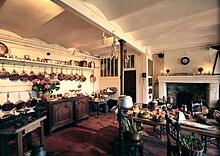Montpoupon Castle
The Montpoupon Castle belongs to the French commune of Céré-la-Ronde in the Indre-et-Loire department of the Center-Val de Loire region . A hunting museum has been located in its farm buildings since 1971.
The palace complex was registered in May 1930 as a Monument historique (French: inscrit). On January 28, 1966, it was classified (French: classé) as a monument historique.
Geography and etymology
Montpoupon, a castellany dependent on Montrichard , existed as early as the 12th century and probably earlier in the valley between Montrichard and Loches .
The name of the castle is derived from the Germanic tribe of the Popponen who settled here on the hill (Mont = mountain) in the Carolingian times. From mons poppo (German: the hill of the Popponen ) became Montpoupon in the course of language development.
history
In the Middle Ages the place was strategically important enough to justify the construction of a castle . Only the towers remain from this 13th century complex.
From the 14th to the 17th century the fiefdom was owned by the de Prie family. The feudal lords were rewarded for their loyalty to the House of Valois with the transfer of important offices, such as that of a chamberlain or that of a grand master of crossbowmen .
The palace complex was expanded in the 14th and 16th centuries according to the requirements of modern warfare. The gate construction, the high residential wing from the 15th century, the west tower and an isolated main tower with battlements and machicolations give an impression of these fortified castles at strategic points of the royal road network , despite the demolition of the walls during the French Revolution .
Montpoupon remained in the possession of the male successors of de Prie until the middle of the 18th century. Thereafter, the lock was inherited from the mother to the daughter. However, the ladies showed little interest in the buildings, which fell into disrepair over time. In 1763, Margrave von Tristan, then mayor of Orléans , bought the property. He improved the leasehold farms and mills, carried out land consolidation and regulated water rights in order to make Montpoupon a lucrative property. In the end, he decided to restore the castle , which was no longer possible due to the revolution.
Around 1840, the new owner of the castle had the farm buildings built, which still exist today. In 1857, Jean Baptiste de la Motte Saint Pierre finally acquired the property. Around 1900 he had work carried out that gave Montpoupon the appearance of the Renaissance again.
architecture
The massive, round donjon with a conically expanded base from the 12th / 13th centuries. Century shows in the upper section a cantilevered walkway resting on consoles with loopholes and small window openings. The conical spire rises above it . This is followed by the elongated residential wing built in the 15th and 16th centuries. On the right-hand side, a corner tower with narrow windows with architraves forms the counterpart to the donjon. The facade of the middle part is designed with cross-frame windows. Lukarnen with decorative late Gothic gables sit on the steep slate roofs .
The entire complex is by a low wall with a round tower and a sentry surrounded from the 16th century. The square gatehouse , reinforced with corner towers , leads into the courtyard with the castle fountain from the 15th century.
exhibition
The entrance pavilion and some rooms of the residential wing are open to visitors , including the bedroom of Marshal Philippe de La Mothe-Houdancourt , who owned the property in the 18th century.
The castle life of past centuries comes to life in the farm buildings. The kitchen with its stove and the many copper pots was used until 1978. In the laundry room (French: lingerie) fine, lace-trimmed, pleated garments from the 19th century are on display. The adjoining horse stable has space for old-time carriages , and old horse harness hangs in the saddlery .
The recently established hunting museum (French: Musée du Veneur ) describes the daily routine of the hobby hunter. Other topics are the care of game and forest, animal breeding, hunter's clothing and the crafts associated with hunting such as saddlery, the manufacture of livery buttons and hunting horns.
literature
- Castles and cities of the Loire . Valoire-Estel, Florence 2006, ISBN 88-476-1863-0 , p. 68.
- Castles on the Loire ; The green travel guide. Michelin Reise-Verlag, Landau-Mörlheim 1997, ISBN 2-06-711591-X , p. 245.
Web links
- Castle website (English, French)
- Photos from Base Mémoire
Individual evidence
- ↑ Castle Montpoupon in the Base Mérimée of the French Ministry of Culture (French), accessed on June 2, 2009.
Coordinates: 47 ° 15 ′ 10.2 " N , 1 ° 8 ′ 29.4" E



